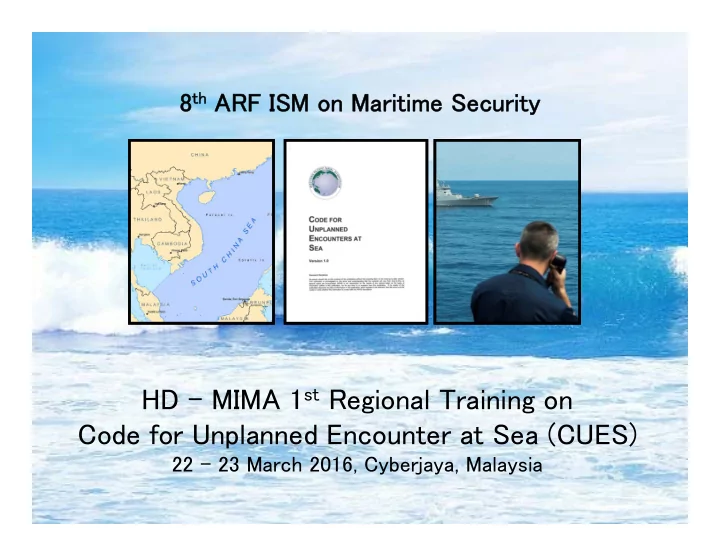

8 th ARF ISM on Maritime Security HD – MIMA 1 st Regional Training on Code for Unplanned Encounter at Sea (CUES) 22 – 23 March 2016, Cyberjaya, Malaysia
Scope of Presentation • Objective of Training • Training section • Training Package • Phases of Training • Observation 2
Objective of Training • To expose the CUES for the relevant stake holder • To deliver better theoretical understanding for the respective agency or organisation • To provide a suitable environment in judging the action based on the CUES • To offer a better option on doing training without deploying the real asset in the South China Sea • Target participant: Navy, Maritime Law Enforcement Agency 3
Three main section • Section 1: Introduction - Definition - Legal Consideration Section 2: Safety Procedures - COLREG 1972 @ ROR Section 3: Communications Procedures - Plain voice - Tactical - Flag 4
MIMA – CUES Training Package Phase 2: Phase 1: Phase 3: Tabletop Theory Simulation Exercise 5
Phase 1: Theory • Focus on understanding the CUES in theoretical perspective • Lesson processes will cover on conceptuality, legality and practicality • Period: 4 hours (1/2 day programme) • Methodology: lecture, presentation and break-out discussion 6
Phase 1: Theory 7
Phase 2: Tabletop Exercise • To discuss a simulated unplanned encounter situation described in CUES • Exercise player will review and discuss the actions they would take in a particular situation and testing their response plan in an informal, low-stress environment • Used to clarify roles and responsibilities and to identify additional risk mitigation and preparedness needs • The exercise will result in action plans for continued improvement of the CUES pre-planned reaction 8
Phase 2: Tabletop Exercise 9
Phase 3: Simulation • A bridge between classroom learning and real-life sea experience • Scenario will be run based on Main Event List (MEL) to represent the most likely scenario in South China Sea • Tempo of the simulation will be assist by inject from simulation controller • Player will have access to practice the procedure inside the CUES with the highest realness. 10
Phase 3: Simulation 11
Observation • Comms procedure varies between countries • Lack of knowledge of other countries SOP • Language barrier in CUES • Lack of knowledge of International Law can lead to misunderstanding and misperception • Multilateral interagency coop is more challenging between the coast guard than between the Navies. 12
Thank You ikmal@mima.gov.my 13
Recommend
More recommend